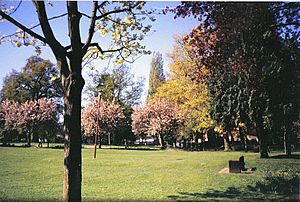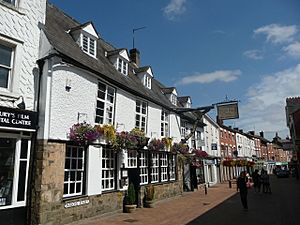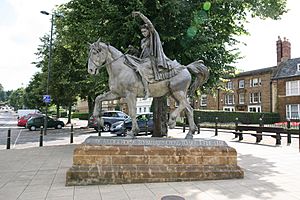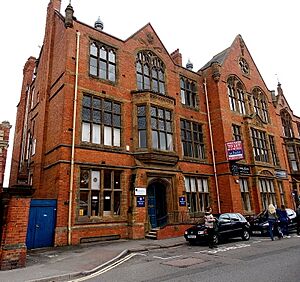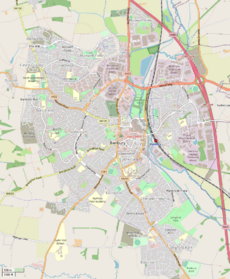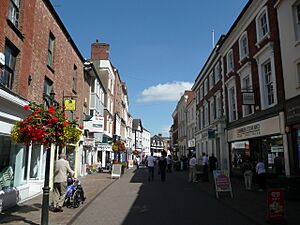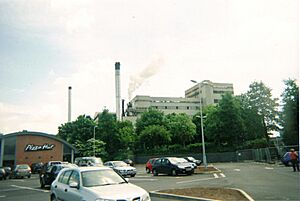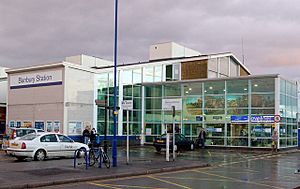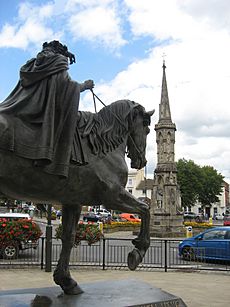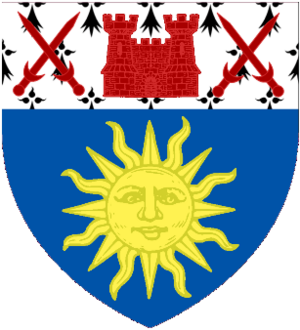Banbury facts for kids
Quick facts for kids Banbury |
|
|---|---|
| Market town | |
|
Clockwise, from top: Banbury Town Hall; The Fine Lady statue and Banbury Cross; Banbury Market Place |
|
| Area | 21.04 km2 (8.12 sq mi) |
| Population | 54,335 (Parish, 2021) 52,045 (Built up area, 2021) |
| OS grid reference | SP4540 |
| • London | 64 mi (103 km) SE |
| District |
|
| Shire county | |
| Region | |
| Country | England |
| Sovereign state | United Kingdom |
| Post town | BANBURY |
| Postcode district | OX16 |
| Dialling code | 01295 |
| Police | Thames Valley |
| Fire | Oxfordshire |
| Ambulance | South Central |
| EU Parliament | South East England |
| UK Parliament |
|
Banbury is an old market town located on the River Cherwell in Oxfordshire, South East England. In 2021, about 54,335 people lived in the town.
Banbury is a busy place for shops and businesses in north Oxfordshire. It also serves parts of Warwickshire and Northamptonshire. The town is known for its industries like motorsport, car parts, and food processing. It's home to the world's largest coffee factory, Jacobs Douwe Egberts, which opened in 1964. Banbury is also famous for its special sweet pastry, Banbury cakes.
The town is about 64 miles (103 km) north-west of London. It is also 37 miles (60 km) south-east of Birmingham and 22 miles (35 km) north-west of Oxford.
Contents
- What does the name Banbury mean?
- A Quick Look at Banbury's History
- What is Banburyshire?
- How Banbury is Governed
- Banbury's Geography and Surroundings
- Businesses and Jobs in Banbury
- Getting Around Banbury
- Media in Banbury
- Fun Places to Visit in Banbury
- Education in Banbury
- Religion in Banbury
- Who Lives in Banbury?
- Sports in Banbury
- Banbury's Twin Towns
- Famous People from Banbury
- Banbury's Coat of Arms
- See also
What does the name Banbury mean?
The name Banbury might come from "Banna," a Saxon leader. He may have built a fort there in the 6th century. Another idea is that "Banna" meant "felon" or "murderer." The second part of the name, "bury," comes from the Old English word burh, meaning "settlement" or "fortified place."
In old Anglo-Saxon times, it was called Banesburh. In the Domesday Book of 1086, it was written as Banesberie.
A Quick Look at Banbury's History
People have lived in the Banbury area for a very long time. Archaeologists have found signs of a British Iron Age settlement from around 200 BC. There was also a Roman villa nearby.
The Saxons settled here around the late 5th century. In 556, a battle took place in Banbury between the Anglo-Saxons and the local Britons. By the mid-6th century, it was an important Saxon settlement. Banbury grew during the Anglo-Saxon period, influenced by the Danes.
The Saxons built Banbury on the west side of the River Cherwell. On the other side, they built Grimsbury. Banbury was important in the Middle Ages because of its wool trade.
Banbury Castle was built in 1135 by Alexander, Bishop of Lincoln. It was used during the English Civil War in the 1640s.
Banbury During the Civil War
During the Civil War, Banbury was close to Oxford, which was the King's capital. At first, Banbury was a Royalist town, supporting King Charles I. However, many people in the town were Puritans, who supported Parliament. The castle was held by Royalist soldiers.
The Reindeer Inn, an old pub, was supposedly used by Oliver Cromwell. He may have prepared for the Battle of Edge Hill there in 1642. After the war, the castle was pulled down.
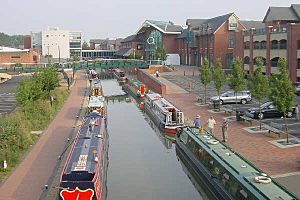
Growth and Transport
The Oxford Canal opened to Banbury in 1778. This brought cheap coal to the town. The canal was later extended to Oxford in 1790. Tooley's Boatyard was the main boat repair yard for the canal.
The railway arrived in Banbury in 1850. This made it easier for people and goods to travel.
People's Park was created in 1890 and opened to the public in 1910.
In the 1950s and 1960s, Banbury grew a lot. New housing estates like Ruscote were built. This was partly because people moved from London.
Banbury used to have a very large cattle market. Farmers would bring animals from far away to be sold. This market closed in 1998, and new homes and a school were built there.
What is Banburyshire?
The name 'Banburyshire' is sometimes used to describe the area around Banbury. This includes parts of Northamptonshire and Warwickshire, as well as north Oxfordshire. This term became popular in the 1800s. Many market towns at that time used "shire" to describe their surrounding area.
Oxfordshire has two main business centres: Oxford in the south and Banbury in the north. Banbury serves towns and villages like Adderbury, Cropredy, and Bloxham. It also serves nearby areas in Northamptonshire and Warwickshire.
How Banbury is Governed
Banbury has three levels of local government:
- Banbury Town Council: This is the local council for the town itself. It is based at Banbury Town Hall. The head of the town council is called the Mayor.
- Cherwell District Council: This council covers a wider area, including Banbury.
- Oxfordshire County Council: This council covers the whole county of Oxfordshire.
Changes in Local Government
For a long time, Banbury was a "borough," which meant it had its own special rules for local government. In 1554, Queen Mary I gave Banbury a charter. This document allowed the town to govern itself more.
Over the years, the way Banbury was governed changed. Different parts of the town had different rules for things like helping the poor. In 1889, the borough of Banbury grew to include more areas, like Grimsbury.
In 1974, the old borough council was replaced. For a while, Banbury didn't have its own town council. Instead, local councillors acted as "charter trustees" to keep the town's traditions alive, including having a mayor.
In 2000, a new Banbury Town Council was created. Since then, the head of this council has been called the Mayor.
Banbury's Geography and Surroundings
Banbury is in the Cherwell Valley. Many hills are in and around the town. Most of Banbury is on a slope, so you often go downhill when entering the town. Estates like Bretch Hill and Hardwick are built on hills, offering great views of the town.
The River Cherwell flows through Banbury, just east of the town centre. Grimsbury is the only part of Banbury east of the river.
Banbury is at the very north of the South East England region. It's close to the borders of the East Midlands and West Midlands regions. This means it has cultural links with nearby Midlands towns like Stratford-upon-Avon and Warwick.
Because of its location by the River Cherwell, Banbury has experienced heavy flooding in the past, for example in 1998 and 2007.
 |
Birmingham Stratford-upon-Avon, Leamington Spa |
Coventry, Rugby Southam |
Daventry, Northampton |  |
| Worcester, Evesham | Brackley, Milton Keynes | |||
| Cheltenham, Chipping Norton | Oxford | Bicester, Aylesbury London |
Businesses and Jobs in Banbury
The Domesday Book from 1086 mentioned three mills in Banbury. These mills were important for grinding grain. In medieval times, there were also butchers' stalls, which were the start of today's shops.
A large aluminium factory, Alcan Industries Ltd., opened in 1931. It closed between 2006 and 2007. Another big employer is Jacobs Douwe Egberts, which makes instant coffee. This factory moved to Banbury in 1965.
In the town centre, many large shops, a bus station, and car parks were built. The Castle shopping centre opened in 1977.
Motorsport in Banbury
Banbury is a hub for the world of motorsport. Many famous companies and race teams are based here. Prodrive, a big motorsport and car technology company, is in Banbury.
Some Formula One teams have had their bases in Banbury. The Simtek team was here in the 1990s. Later, the Marussia F1 team had its factory here. After Marussia F1 closed, the Haas F1 Team from the United States bought their base. They use it to work on their cars during European races.
Arden Motorsport, a British racing team, is also based in Banbury.
Jobs in Banbury
Banbury has one of the lowest unemployment rates in the UK. This means most people who want to work can find a job. After Poland joined the European Union in 2004, many Polish people came to Banbury to work. In 2006, it was estimated that 5,000 to 6,000 Poles lived in the town.
Major Companies and Charities
- Jacobs Douwe Egberts: A large factory making coffee and other food products. It's been a major employer since the 1960s.
- Westminster Group
- Norbar
- Arrival
- Waste & Resources Action Programme
- Dogs for Good: A charity that trains assistance dogs.
- Warburtons: A well-known bakery company.
Banbury's Cattle Market
Banbury used to have one of Western Europe's largest cattle markets. It was on Merton Street in Grimsbury. Farmers would bring cattle and other animals from far away to be sold. This market closed in 1998. Now, new homes and Dashwood Primary School are on the site.
Getting Around Banbury
Trains
Banbury railway station is served by three train companies:
- Chiltern Railways: Trains run between Birmingham and London Marylebone.
- Great Western Railway: Trains go to Oxford and Didcot Parkway.
- CrossCountry: Trains travel between Manchester and Bournemouth, stopping at Banbury.
Buses and Coaches
Stagecoach in Oxfordshire runs most of the bus routes in Banbury. They have buses within the town and to nearby places like Oxford, Brackley, and Stratford-upon-Avon.
Roads
Hennef Way (A422) was made into a dual carriageway. This helps traffic flow better and connects north Banbury and the town centre to the M40 motorway.
Canal
The Oxford Canal is popular for boat trips and tourism. Tooley's Boatyard is a historic site on the canal.
Media in Banbury
The Banbury Guardian is a local newspaper published every Thursday. The Banbury Cake used to be a free newspaper, but it stopped printing in 2017.
For TV news, Banbury gets regional news from BBC South and ITV Meridian. Local radio stations include BBC Radio Oxford, Heart South, and Capital Mid-Counties.
Fun Places to Visit in Banbury
Banbury Cross
Long ago, Banbury had many crosses, but they were destroyed in 1600. For over 250 years, Banbury had no cross. The current Banbury Cross was built in 1859. It celebrates the marriage of Queen Victoria's eldest child, Princess Victoria.
The cross is a tall, stone monument with a spire shape. Statues of Queen Victoria, Edward VII, and George V were added in 1914. The cross is 52 feet (16 m) high.
The famous English nursery rhyme "Ride a cock horse to Banbury Cross" might refer to one of the old crosses. In 2005, Princess Anne unveiled a large bronze statue of the Fine Lady on a White Horse from the nursery rhyme. It stands near the Banbury Cross.
Banbury Museum & Gallery
Banbury has a museum in the town centre, close to Spiceball Park. You can reach it from the Castle Quay Shopping Centre. Entry to the museum is free. The town's tourist information centre is also located here.
Tooley's Boatyard
Tooley's Boatyard was built in 1778. It's a historic place with a nearly 250-year-old blacksmith's shop and a dry dock for narrow boats.
Spiceball Centre and Park
Spiceball Park is the biggest park in Banbury. It has three large fields, a children's play area, and a skateboard park. Across the road is the Spiceball sports centre. It has a swimming pool, sports courts, and a gym. The sports centre was updated in 2009-2010.
Other Parks and Green Spaces
Neithrop is home to People's Park, which opened in 1910. It has a bird house, tennis courts, and a play area. The park is often used for small festivals in the summer. Easington Recreation Ground is another important park.
Interesting Place Names
- Tom Rolt Bridge: Since 1999, bridge 164 on the Oxford Canal has been named after Tom Rolt. He wrote a famous book called Narrow Boat.
- Concorde Avenue: This road was named in 1995 to celebrate 50 years of peace in Europe since the Second World War.
- Claypits Close: Built around 2007, this road is named after an old clay pit that used to be there.
- Gillett Road: Named after Joseph Ashby Gillett, who ran a bank in Banbury in the 1700s, or his descendant Sarah Beatrice Gillett, who was mayor in 1926.
Education in Banbury
Banbury has several schools and colleges:
- Banbury and Bicester College: Part of Activate Learning.
- Fairleigh Dickinson University: One of its international campuses is at Wroxton Abbey near Banbury.
- Secondary Schools: North Oxfordshire Academy, Wykham Park Academy, Space Studio Banbury, and Blessed George Napier Roman Catholic School.
- Primary Schools: There are many primary schools in the town.
- Independent Schools: These include Tudor Hall and Al-Madina School.
Religion in Banbury
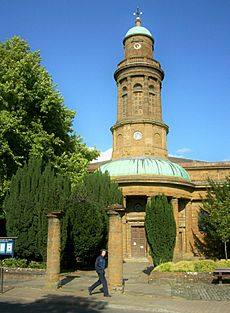
In 1377, a Welshman was pardoned for a crime after he found safety in St Mary's parish church. In 1589, there were riots in the Neithrop area after Puritans destroyed a maypole.
Reverend William Whateley was a well-known vicar of Banbury in the early 1600s. The Quaker meeting house in Banbury was built between 1748 and 1750. In 1838, the Catholic St John the Evangelist Church was built. Parts of it were designed by Augustus Pugin.
Who Lives in Banbury?
In 2021, the population of Banbury was 54,335. This was an increase from 46,853 in 2011.
Here's a look at the different groups of people in Banbury in 2021:
- 84.3% were White
- 8.8% were Asian
- 2.3% were Black
- 3.1% were Mixed
- 1.2% were from other ethnic groups.
In terms of religion in 2021:
- 50.6% were Christian
- 40.0% said they had no religion
- 6.9% were Muslim
- 0.7% were Hindu
- 0.6% were Sikh
- 0.6% were Buddhists
- 0.6% were from another religion.
Sports in Banbury
Banbury has many sports clubs for different ages and skill levels.
- Football: Banbury United F.C. is the town's main football club. It started in 1931 as Spencer Villa.
- Rugby: There is a rugby club called Banbury RUFC.
- Other sports include canoeing, golf, running, triathlon, and cricket.
A greyhound racing track opened in Banbury in 1951 but closed a few years later in 1954.
Many motor racing teams have been based in Banbury. The American Haas F1 Team has its European base here. Other teams like Prodrive and Manor Racing have also been in Banbury.
Banbury's Twin Towns
Banbury is "twinned" with two towns in other countries. This means they have a special friendship and exchange visits.
- Ermont in France (since 1982)
- Hennef in Germany (since 1981)
Twinning started in Banbury in 1978. The first formal agreement was signed with Ermont in 1982. Contact with Hennef began in 1980, and an agreement was signed within a year. Because of these friendships, two roads in Banbury are named after the twin towns: Hennef Way and Ermont Way. In Hennef, a square is named Banburyplatz.
Famous People from Banbury
- Alfie Barbeary: A rugby player.
- Anthony Burgess: A novelist who taught at Banbury Grammar School in the 1950s.
- Larry Grayson: A comedian and TV presenter, born in Banbury.
- Richie Hawtin: An electronic musician and DJ, born in Banbury.
- Alan Hodgkin: A British scientist who won the Nobel Prize in Physiology and Medicine.
- Lancelot Holland: An admiral who grew up in the Banbury area.
- Chris Hughes: A TV hypnotist, born in Banbury.
- Jo Joyner: An actress known for EastEnders, who grew up nearby.
- Lord North: A former Prime Minister who was an MP for Banbury.
- Tim Plester: An actor, playwright, and filmmaker, born and raised in Banbury.
- Gordon Ramsay: The famous chef, moved to Banbury at age 16.
- Rodney Gould: A former Grand Prix motorcycle racer, born in Banbury.
Banbury's Coat of Arms
See also
 In Spanish: Banbury para niños
In Spanish: Banbury para niños






